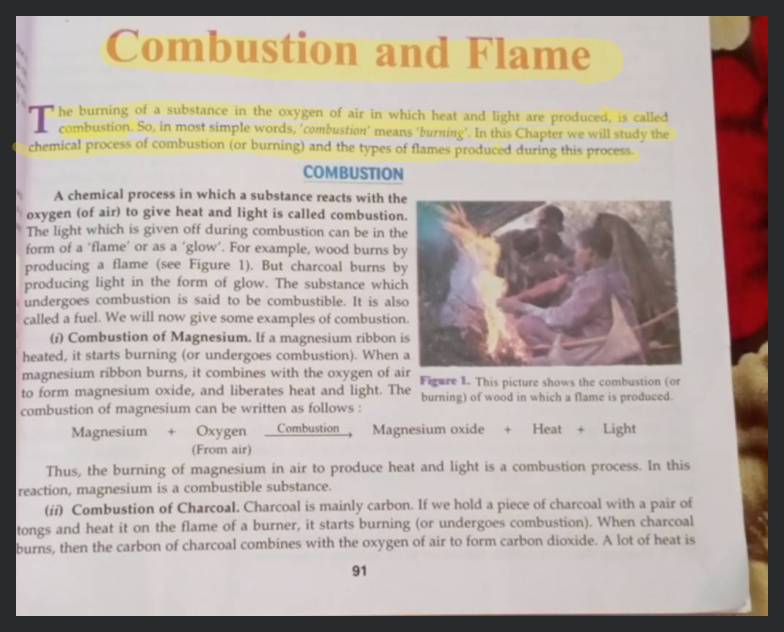Question
Question asked by Filo student

Combustion and Flame The burning of a substance in the oxygen of air in which heat and light are produced, is called combustion. So, in most simple words, 'combustion' means 'burning'. In this Chapter we will study the chemical process of combustion (or burning) and the types of flames produced during this process. COMBUSTION A chemical process in which a substance reacts with the oxygen (of air) to give heat and light is called combustion. The light which is given off during combustion can be in the form of a 'flame' or as a 'glow'. For example, wood burns by producing a flame (see Figure 1). But charcoal burns by producing light in the form of glow. The substance which undergoes combustion is said to be combustible. It is also called a fuel. We will now give some examples of combustion. (i) Combustion of Magnesium. If a magnesium ribbon is heated, it starts burning (or undergoes combustion). When a magnesium ribbon burns, it combines with the oxygen of air to form magnesium oxide, and liberates heat and light. The combustion of magnesium can be written as follows : Feare 1. This picture shows the combustion (or burning) of wood in which a flame is produced. Thus, the burning of magnesium in air to produce heat and light is a combustion process. In this reaction, magnesium is a combustible substance. (ii) Combustion of Charcoal. Charcoal is mainly carbon. If we hold a piece of charcoal with a pair of tongs and heat it on the flame of a burner, it starts burning (or undergoes combustion). When charcoal burns, then the carbon of charcoal combines with the oxygen of air to form carbon dioxide. A lot of heat is 91
Found 8 tutors discussing this question
Discuss this question LIVE
6 mins ago

One destination to cover all your homework and assignment needs
Learn Practice Revision Succeed

Instant 1:1 help, 24x7
60, 000+ Expert tutors

Textbook solutions
Big idea maths, McGraw-Hill Education etc

Essay review
Get expert feedback on your essay

Schedule classes
High dosage tutoring from Dedicated 3 experts
Practice more questions on Chemistry
Question 1
Hard
Views: 6,362
Question 2
Medium
Views: 5,621
(a) acceleration of the body during the first three seconds of its motion.
(b) deceleration of the body during the last second of its motion.
(c) displacement of the body at the end of 4 s.
Question 3
Views: 5,353
Question 4
Medium
Views: 6,200
(a) moves in a straight line with a constant speed of for 12 seconds.
(b) changes its velocity from to in .
Students who ask this question also asked
Question 1
Views: 5,082
Question 2
Views: 5,244
Question 3
Views: 5,234
Question 4
Views: 5,994


Stuck on the question or explanation?
Connect with our Science tutors online and get step by step solution of this question.
231 students are taking LIVE classes
| Question Text | Combustion and Flame
The burning of a substance in the oxygen of air in which heat and light are produced, is called combustion. So, in most simple words, 'combustion' means 'burning'. In this Chapter we will study the chemical process of combustion (or burning) and the types of flames produced during this process.
COMBUSTION
A chemical process in which a substance reacts with the oxygen (of air) to give heat and light is called combustion. The light which is given off during combustion can be in the form of a 'flame' or as a 'glow'. For example, wood burns by producing a flame (see Figure 1). But charcoal burns by producing light in the form of glow. The substance which undergoes combustion is said to be combustible. It is also called a fuel. We will now give some examples of combustion.
(i) Combustion of Magnesium. If a magnesium ribbon is heated, it starts burning (or undergoes combustion). When a magnesium ribbon burns, it combines with the oxygen of air to form magnesium oxide, and liberates heat and light. The combustion of magnesium can be written as follows :
Feare 1. This picture shows the combustion (or burning) of wood in which a flame is produced.
Thus, the burning of magnesium in air to produce heat and light is a combustion process. In this reaction, magnesium is a combustible substance.
(ii) Combustion of Charcoal. Charcoal is mainly carbon. If we hold a piece of charcoal with a pair of tongs and heat it on the flame of a burner, it starts burning (or undergoes combustion). When charcoal burns, then the carbon of charcoal combines with the oxygen of air to form carbon dioxide. A lot of heat is
91 |
| Updated On | Nov 3, 2023 |
| Topic | Chemistry |
| Subject | Science |
| Class | Class 9 |
| Answer Type | Video solution: 1 |
| Upvotes | 65 |
| Avg. Video Duration | 1 min |




